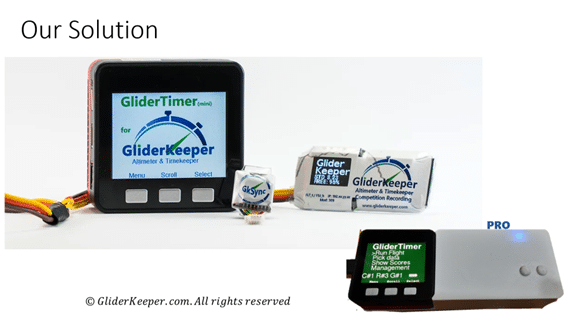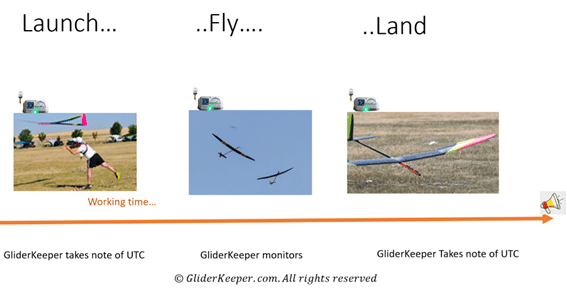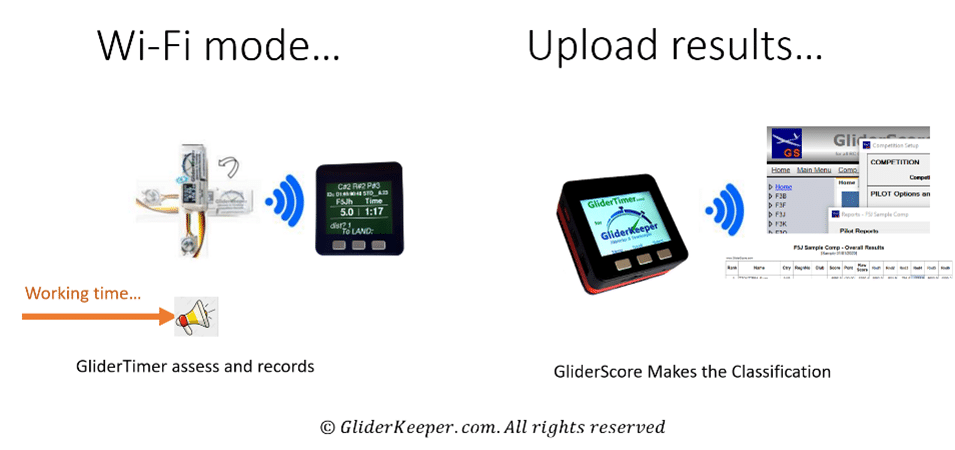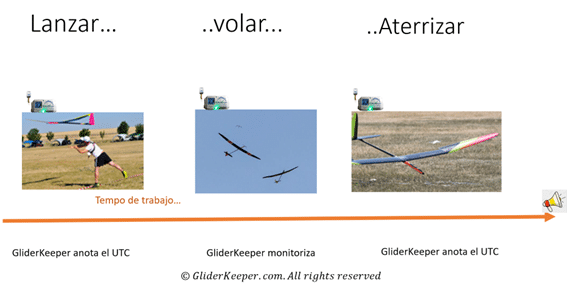[Versión en Español más abajo]
[EN]
Dear Pilot,
Bulletin No 4, April 26th 2022
We want to tell you today how we will be conducting our “almost automated” competition.
We will be using our F5J competition management system.

Every model will have on board a GliderKeeper and a GKSync. While in ground several GliderTimers will be in hands of our human timekeepers and one GliderTimer PRO will be in charge of moving the Annunciator Panel and Audio Tracks.
The air segment:
GliderKeeper will calculate the flight duration in between throttle movement and model touchdown.
While essentially GKSync will be telling GliderKeeper at what hour hh:mm:ss, and milliseconds, those events happened. GKSync is very much a good quality chronometer that keeps the UTC Universal Time Coordinated.
The Ground Segment:
The fleet of GliderTimers will know exactly at what hour did the working time start and finish.

When a pilot lands, the human timekeeper, with a GliderTimer ready, will take note of the landing distance of this flight and then she/he will ask the pilot to make the model enter in Wi-Fi mode. GliderKeeper will notice the proximity of GliderTimer and will transmit flight duration and launch and landing exact times.

With this information GliderTimer will confirm or not the flight was made within working time, will ask for inputting landing distance or will trim the flight time to the end of working time and then will refuse to take landing distance. And then it will store this flight information.

This process will be repeated for every pilot in competition.
To expedite the competition, one human timekeeper will be in charge of 3 or 4 pilots.
And also, will be monitoring the pilots follow the rules, safety corridor, no part of the model is missing etc.
Once all pilots have been taken, these data in the GliderTimers, 3 or 4 will be wirelessly transmitted to GliderTimer PRO and from this to a main computer where the GliderScore competition will be maintained.
This fact allows us to accept pilots which do not carry a GliderKeeper: a person will be manually taken flight data for them and then transfered to GliderScore.
The competition will be housed in GliderScore and the draw will be done by GliderScore no matter the altimeter tha pilot has.
The only thing we will be modulating from this draw is, for mechanical reasons, pilots without a GliderKeeper will be in the midpoint of the pilot’s line.
GliderTimers will know which pilot is flying by the ID of the GliderKeeper on board which is as well transmitted. This is why we are asking you for the ID of your units. A pilot can have up to 3 ID´s corresponding to the 3 permitted planes in the rules.
It is also very important “all” the clocks are in the hour so we will be asking to “synchronize” your GKSyncs every 6 hours.
GliderTimers do have a very similar clock so they also have to be Synced in these periods, this precaution allows us to claim we are much more accurate than a human perceiving a touchdown.
The Synchro is made via the internet and it is good we use the same mobile cell to improve accuracy.
Do not worry if you did not bring your GKSync we will have several for you to borrow during competition.
We will keep a paper copy of your results but just as a back up being the masters the recording of GliderTimer.
[ES]
Estimado piloto,
Bulletin No 4, 26 Abril 2022
Hoy queremos contaros cómo vamos a llevar a cabo nuestra competición “casi automatizada”.

Utilizaremos nuestro sistema de gestión de competición F5J.
Cada modelo tendrá a bordo un GliderKeeper y un GKSync. Mientras en tierra varios GliderTimer estarán en manos de nuestros cronometradores humanos y un GliderTimer PRO se encargará de mover el Panel de Marcador y las Pistas de Audio.
El segmento aéreo:
GliderKeeper calculará la duración del vuelo entre el movimiento de los gases y el aterrizaje del modelo.
Mientras que esencialmente GKSync le dirá a GliderKeeper a qué hora hh:mm:ss, y milisegundos, ocurrieron esos eventos. GKSync es en gran medida un cronómetro de buena calidad que mantiene el tiempo universal coordinado UTC.
El segmento de tierra:
La flota de GliderTimer sabrá exactamente a qué hora comenzó y terminó el tiempo de trabajo.

Cuando un piloto aterriza, el cronometrador humano, con un GliderTimer preparado, tomará nota de la distancia de aterrizaje de este vuelo y entonces le pedirá al piloto que haga entrar el modelo en modo Wi-Fi. GliderKeeper notará la proximidad de GliderTimer y transmitirá la duración del vuelo y las horas exactas de despegue y aterrizaje.

Con esta información GliderTimer confirmará si el vuelo se ha realizado dentro del tiempo de trabajo, pedirá que se introduzca la distancia de aterrizaje o recortará el tiempo de vuelo hasta el final del tiempo de trabajo y entonces rechazará tomar la distancia de aterrizaje. Y luego almacenará esta información de vuelo.
Este proceso se repetirá para cada piloto en competición.

Para agilizar la competición, un cronometrador humano estará a cargo de 3 o 4 pilotos. Y, además, estará vigilando que los pilotos sigan las reglas, la seguridad del corredor, que no falte ninguna parte del modelo, etc.
Una vez que todos los pilotos han sido registrados, estos datos en los GliderTimer, 3 o 4 serán transmitidos de forma inalámbrica a GliderTimer PRO y de éste a un ordenador principal donde se mantendrá la competición en GliderScore.
Este hecho nos permite aceptar a los pilotos que no lleven un GliderKeeper: se les tomarán manualmente los datos de vuelo y se transferirán a GliderScore.
La competición se alojará en GliderScore y el sorteo lo hará GliderScore sin importar el altímetro que tenga el piloto.
Lo único que modularemos de este sorteo es que, por razones mecánicas, los pilotos sin GliderKeeper estarán en el punto medio de la línea de pilotos.
Los GliderTimer sabrán qué piloto está volando por el ID del GliderKeeper a bordo, que también se transmite. Por eso os pedimos el ID de vuestras unidades. Un piloto puede tener hasta 3 ID’s correspondientes a los 3 aviones permitidos en las reglas.
También es muy importante que “todos” los relojes estén en la hora por lo que te pediremos que “sincronices” tus GKSyncs cada 6 horas.
Los GliderTimer tienen un reloj muy similar, por lo que también tienen que ser sincronizados en estos periodos, esta precaución nos permite afirmar que somos mucho más precisos que un humano percibiendo un touchdown.
La Sincronización se hace vía internet y es bueno que usemos la misma célula móvil para mejorar la precisión.
No te preocupes si no has traído tu GKSync tendremos varios de préstamo durante la competición.
Mantendremos una copia de los resultados en papel pero solo como salvaguarda siendo los datos maestros los registrados el GliderTimer.

